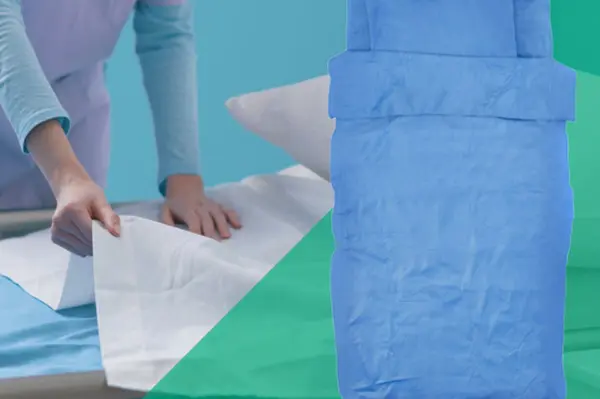Medical bedding plays a crucial role in maintaining hygiene, patient comfort, and overall safety in healthcare settings such as hospitals, nursing homes, and clinics. One of the most important components of medical bedding is the medical bed sheet, which is designed to provide a clean and comfortable surface for patients. These sheets are crafted from specialized materials that ensure durability, ease of cleaning, and resistance to contaminants like bacteria, viruses, and fluids. In this article, we’ll explore the various materials used in medical bedding, focusing on how they meet the rigorous demands of healthcare environments.
1. Cotton and Cotton Blends
Cotton is one of the most commonly used materials for making medical bed sheets. Known for its softness, breathability, and hypoallergenic properties, cotton is an ideal choice for patient comfort. In healthcare, cotton is often blended with synthetic fibers to enhance durability and make it easier to launder at high temperatures. The advantages of using cotton and cotton blends in medical bedding include:
- Comfort: Cotton sheets are soft, breathable, and gentle on the skin, making them ideal for long-term use, especially for patients who may have sensitive skin or are bedridden for extended periods.
- Moisture Absorption: Cotton is highly absorbent, which helps to wick away moisture, keeping the patient dry and comfortable. This is especially important in preventing pressure sores and skin irritation for patients with limited mobility.
- Durability: When blended with synthetic fibers like polyester, cotton sheets become more durable, capable of withstanding frequent laundering and high-temperature sterilization. This makes them cost-effective and practical for medical facilities.
Many medical bed sheets made from cotton blends are treated with special coatings to enhance their resistance to stains, fluids, and microbial growth. These treatments ensure that the bedding remains hygienic even after repeated use.
2. Polyester and Polyester Blends
Polyester is a synthetic fiber known for its strength, durability, and resistance to shrinkage. Polyester or polyester-blended fabrics are widely used in medical bed sheets because they can withstand the high demands of healthcare environments, where frequent washing and disinfecting are essential.
- Durability: Polyester sheets are less likely to tear or wear out, making them ideal for high-traffic hospital beds where bedding is changed frequently. They maintain their shape and integrity even after multiple washes, which is essential in environments where cleanliness and hygiene are critical.
- Low Absorbency: Unlike cotton, polyester is less absorbent, which can help prevent the buildup of moisture on the bed. This makes polyester sheets a good option for protecting mattresses and keeping patients dry.
- Cost-Effective: Polyester is generally less expensive than natural fibers, making it a cost-effective solution for healthcare facilities that need to purchase large quantities of bedding.
Polyester is often blended with cotton to combine the benefits of both fibers, resulting in a durable, comfortable, and easy-to-maintain medical bed sheet.
3. Vinyl and PVC-Coated Fabrics
Vinyl and PVC (polyvinyl chloride) are synthetic materials commonly used for waterproof medical bedding, particularly for mattress covers and protective layers. These materials are designed to prevent liquids, such as bodily fluids or cleaning solutions, from penetrating the fabric and contaminating the mattress. Vinyl and PVC-coated medical bed sheets are especially useful in preventing cross-contamination and reducing the spread of infections in healthcare settings.
- Waterproof: The primary advantage of vinyl and PVC-coated fabrics is their ability to repel fluids, ensuring that the mattress stays dry and protected. This makes them particularly valuable in hospital environments where patients may have incontinence issues or where there is a need for heightened infection control.
- Easy to Clean: These materials are non-porous and can be easily wiped down and disinfected between uses, ensuring that the bedding remains hygienic and safe for each new patient. This reduces the risk of transmitting infectious diseases between patients.
- Durability: Vinyl and PVC-coated fabrics are highly durable and resistant to wear and tear, making them a practical choice for hospitals and clinics where bedding is subject to heavy use.
However, vinyl and PVC materials are not as breathable or comfortable as cotton or polyester, so they are typically used as mattress protectors rather than for direct patient contact.
4. Tencel and Other Sustainable Fibers
As healthcare facilities increasingly prioritize sustainability, eco-friendly materials like Tencel (lyocell) have started gaining traction in the production of medical bed sheets. Tencel is derived from wood pulp and is known for its softness, breathability, and environmentally friendly production process.
- Eco-Friendly: Tencel is produced using a closed-loop process, where almost all chemicals used in its manufacturing are recycled, reducing environmental impact. This makes it an attractive choice for healthcare facilities looking to reduce their carbon footprint.
- Moisture-Wicking: Tencel fibers are excellent at absorbing and dissipating moisture, which helps keep patients cool and comfortable. This property is especially useful in hospital settings where patients may experience excessive sweating due to illness or treatment.
- Antimicrobial Properties: Tencel naturally resists the growth of bacteria and other microbes, making it a hygienic choice for medical bed sheets. This can help reduce the risk of hospital-acquired infections.
While Tencel and other sustainable fibers are still relatively new in the medical bedding market, they offer promising alternatives to traditional materials.
5. Disposable Medical Bed Sheets
In situations where infection control is critical, such as during the COVID-19 pandemic or in isolation wards, disposable medical bed sheets are often used. These sheets are made from non-woven materials, such as polypropylene, and are designed for single use. After use, they are discarded, reducing the risk of cross-contamination.
- Convenience: Disposable bed sheets are easy to replace and dispose of, ensuring that each patient has a clean, uncontaminated surface to rest on.
- Hygiene: Since they are used only once, disposable sheets eliminate the need for laundering, reducing the risk of transmitting infections between patients.
However, disposable sheets are typically less comfortable than reusable sheets made from cotton or polyester, and they may not be as durable.
Conclusion
Medical bedding is a critical component of patient care, designed to meet the high standards of cleanliness, durability, and comfort required in healthcare settings. Medical bed sheets are typically made from cotton, polyester blends, or synthetic materials like vinyl or PVC to protect against fluids and contaminants. Sustainable options like Tencel are also gaining popularity for their eco-friendly properties. Whether it’s for patient comfort, infection control, or durability, the materials used in medical bedding are carefully chosen to ensure a safe and hygienic environment in healthcare facilities.
Post time: 9月-23-2024






